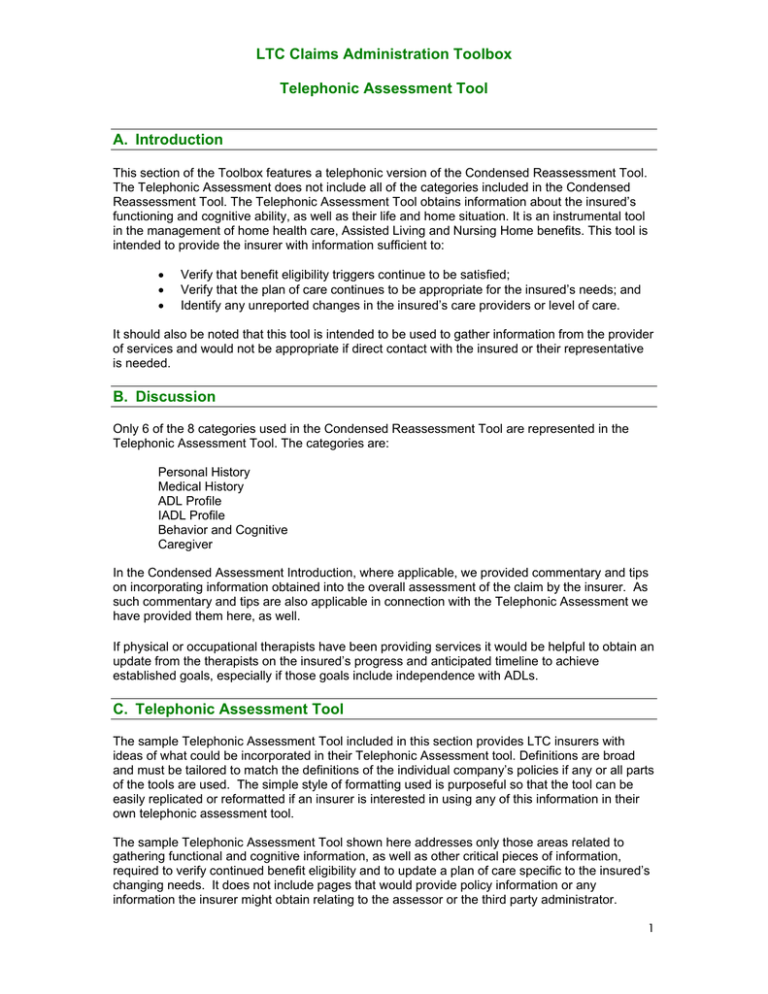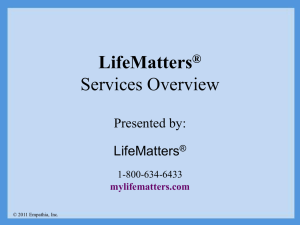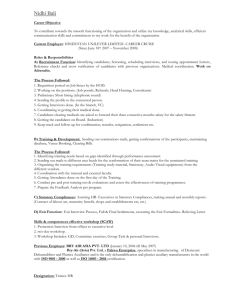LTC Claims Administration Toolbox Telephonic Assessment Tool A. Introduction
advertisement

LTC Claims Administration Toolbox Telephonic Assessment Tool A. Introduction This section of the Toolbox features a telephonic version of the Condensed Reassessment Tool. The Telephonic Assessment does not include all of the categories included in the Condensed Reassessment Tool. The Telephonic Assessment Tool obtains information about the insured’s functioning and cognitive ability, as well as their life and home situation. It is an instrumental tool in the management of home health care, Assisted Living and Nursing Home benefits. This tool is intended to provide the insurer with information sufficient to: • • • Verify that benefit eligibility triggers continue to be satisfied; Verify that the plan of care continues to be appropriate for the insured’s needs; and Identify any unreported changes in the insured’s care providers or level of care. It should also be noted that this tool is intended to be used to gather information from the provider of services and would not be appropriate if direct contact with the insured or their representative is needed. B. Discussion Only 6 of the 8 categories used in the Condensed Reassessment Tool are represented in the Telephonic Assessment Tool. The categories are: Personal History Medical History ADL Profile IADL Profile Behavior and Cognitive Caregiver In the Condensed Assessment Introduction, where applicable, we provided commentary and tips on incorporating information obtained into the overall assessment of the claim by the insurer. As such commentary and tips are also applicable in connection with the Telephonic Assessment we have provided them here, as well. If physical or occupational therapists have been providing services it would be helpful to obtain an update from the therapists on the insured’s progress and anticipated timeline to achieve established goals, especially if those goals include independence with ADLs. C. Telephonic Assessment Tool The sample Telephonic Assessment Tool included in this section provides LTC insurers with ideas of what could be incorporated in their Telephonic Assessment tool. Definitions are broad and must be tailored to match the definitions of the individual company’s policies if any or all parts of the tools are used. The simple style of formatting used is purposeful so that the tool can be easily replicated or reformatted if an insurer is interested in using any of this information in their own telephonic assessment tool. The sample Telephonic Assessment Tool shown here addresses only those areas related to gathering functional and cognitive information, as well as other critical pieces of information, required to verify continued benefit eligibility and to update a plan of care specific to the insured’s changing needs. It does not include pages that would provide policy information or any information the insurer might obtain relating to the assessor or the third party administrator. 1 LTC Claims Administration Toolbox Telephonic Assessment Tool D. ADL Assessment The information collected in the Activities of Daily Living (ADL) section will typically be reported by the care providers. Information obtained is used for care planning purposes to ensure previously established goals remain appropriate and achievable. If the insured is in an assisted living or skilled nursing facility, the assessor could request a copy of the facility’s current plan of care or medical records if necessary E. Cognitive Assessment The information contained in this section of the Introduction is not the same as that shown in the Introduction for the On Site Assessment Tool and the Condensed Reassessment Tool. Behavioral and Cognition Assessment The Behavioral and Cognition Assessment questions used in this section need to be clear and include detail instructions to elicit sufficient information about the insured’s cognitive ability. This may help limit interpretive errors by the assessor conducting the Telephonic Assessment and reduce variability across assessors for determining if the benefit triggers have been met. 2




